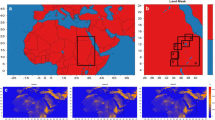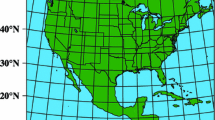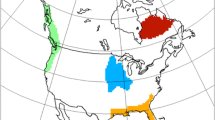Abstract
The atmospheric branch of the hydrological cycle associated with the East Asian summer monsoon is intricate due to its distinct land-sea configurations: the highest mountains are to its west, the oceans are to its south and east, and mid-latitude influences come from its north. Here we use the weather research and forecast (WRF) model to demonstrate that using two different large-scale driving fields, derived from the NCEP/DOE R2 and ERA40 reanalysis data and the same model configuration yielded remarkable differences. We found that the differences are primarily caused by uncertainties in the water vapor influx across the lateral boundaries in the reanalyses. The summer-mean water vapor convergence into the model domain computed from the ERA40 reanalysis is 47% higher than that from the R2 reanalysis. The largest uncertainties in moisture transport are found in the regions of the Philippine Sea and the Bay of Bengal, where the moisture transport has the most significant impacts on the East Asian summer monsoon rainfall distribution. The sensitivity test results suggest that the biases in the seasonal mean, seasonal march of the rain band, and individual rainfall events may be reduced by using an “ensemble” average of R2 and ERA40 as lateral boundary forcing. While the large-scale forcing field does not conserve water vapor, the WRF simulation conserves water vapor in the inner model domain. The regional model simulation has corrected the biases in the total amount and the month-to-month distribution of precipitation in the large-scale driving field. However, RCM’s daily precipitation is poorer than that in the reanalysis filed. Since the RCM solutions may sensitively depend on the reanalysis forcing, intercomparison of models’ performance based on a single set of the reanalysis may not be reliable. This calls for attention to reshape our strategy for validation of RCMs.








Similar content being viewed by others
References
Anderson CJ, Arritt RW, Takle ES, Pan Z, Gutowski WJ, Otieno FO, Silva RD, Caya D, Christensen JH, Lüthi D, Gaertner MA, Gallardo C, Giorgi F, Hong S-Y, Jones C, Juang H-M, Katzfey JJ, Lapenta WM, Laprise R, Larson JW, Liston GE, McGregor JL, Pielke RA, Roads JO, Taylor JA (2003) Hydrologic processes in regional climate model simulations of the central United States flood of June-July 1993. J Hydrometeor 4:584–598
Beniston M, Stephenson D, Christensen O, Ferro C, Frei C, Goyette S, Halsnaes K, Holt T, Jylhae K, Koffi B, Palutikof J, Schoell R, Semmler T, Woth K (2007) Future extreme events in European climate: an exploration of regional climate model projections. Clim Change 81(s1):71
Bhaskaran B, Jones RG, Murphy JM, Noguer M (1996) Simulations of the Indian summer monsoon using a nested regional climate model: Domain size experiments. Climate Dyn 12:573–587
Chen F, Dudhia J (2001) Coupling an advanced land surface-hydrology model with the Penn State-NCAR MM5 modeling system. Part I: model implementation and sensitivity. Mon Wea Rev 129:569–585
Chen S-H, Sun W-Y (2002) A one-dimensional time dependent cloud model. J Meteor Soc Jpn 80:99–118
Chen T-C (2006) Variation of the Asian monsoon water vapor budget: Interaction with the global-scale modes. In: Wang B (ed) The Asian monsoon. Springer, Berlin, pp 417–457
Christensen JH, Machenhauer B, Jones RG, Schar C, Ruti PM, Castro M, Visconti G (1997) Validation of present-day regional climate simulations over Europe: LAM simulations with observed boundary conditions. Climate Dyn 13:489–506
Curry JA, Lynch AH (2002) Comparing arctic regional climate models. Eos Trans Am Geophys Union 83:87
Denis B, Laprise R, Caya D, Coté J (2002) Downscaling ability of one-way nested regional climate models: the Big-Brother Experiment. Climate Dyn 18:627–646
Ding Y, Liu Y (2001) Onset and the evolution of the summer monsoon over the South China Sea during SCSMEX field experiment in 1998. J Meteor Soc Jpn 79:255–276
Ding Y, Sikka DR (2006) Synoptic systems and weather. In: Wang B (ed) The asian monsoon. Springer, Berlin, pp 131–202
Dudhia J (1989) Numerical study of convection observed during the winter monsoon experiment using a mesoscale two-dimensional model. J Atmos Sci 46:3077–3107
Fasullo J, Webster PJ (2002) Hydrological signatures relating the Asian summer monsoon and ENSO. J Clim 15:3082–3095
Fu C, Wang S, Zhe X, Gutowski WJ, Lee D-K, McGregor JL, Sato Y, Kato H, Kim J-W, Suh M-S (2005) Regional climate model intercomparison project for Asia. Bull Am Meteor Soc 86:257–266
Giorgi F, Bi X (2000) A study of internal variability of a regional climate model. J Geophys Res 105:29503–29521
Giorgi F, Mearns LO (1999) Introduction to special section: regional climate modeling revisited. J Geophys Res 104:6335–6352
Hong S-Y, Leetmaa A (1999) An evaluation of the NCEP RSM for regional climate modeling. J Clim 12:592–609
Huffman GJ, Adler RF, Morrissey MM, Bolvin DT, Curtis S, Joyce R, McGavock B, Susskind J (2001) Global precipitation at one-degree daily resolution from multiSatellite observations. J Hydrometeor 2:36–50
Jacob D, Podzun R (1997) Sensitivity studies with the regional climate model REMO. Meteor Atmos Phys 63:119–129
Janjic ZI (2000) Comments on “Development and evaluation of a convection scheme for use in climate models”. J Atmos Sci 57:3686
Jones RG, Murphy JM, Noguer M (1995) Simulation of climate change over Europe using a nested regional-climate model. Part I: assessment of control climate, including sensitivity to location of boundaries. Q J R Meteor Soc 121:1413–1449
Kanamitsu M, Ebisuzaki W, Woollen J, Yang S-K, Hnilo JJ, Fiorino M, Potter GL (2002) NCEP-DOE AMIP-II Reanalysis (R-2). Bull Am Meteor Soc 83:1631–1643
Krishnamurti TN, Bhalme HN (1976) Oscillations of monsoon system. Part I: observational aspects. J Atmos Sci 33:1937–1954
Krishnamurti TN, Kishtawal CM, Zhang Z, LaRow TE, Bachiochi DR, co-authors (1999) Improved weather and seasonal climate forecasts from multi-model superensemble. Science 285:1548–1550
Leung LR, Ghan SJ (1999) Pacific Northwest climate sensitivity simulated by a regional climate model driven by a GCM. Part I: control simulations. J Clim 12:2010–2030
Liang X-Z, Kunkel KE, Samel AN (2001) Development of a regional climate model for US midwest applications. Part I—sensitivity to buffer zone treatment. J Clim 14:4363–4378
Liang X-Z, Li L, Kunkel KE, Ting M, Wang JX (2004) Regional climate model simulation of US precipitation during 1982–2002. Part I: annual cycle. J Clim 17:3510–3529
Lin Y-L, Farley RD, Orville HD (1983) Bulk parameterization of the snow field in a cloud model. J Clim Appl Meteor 22:1065–1092
Miyakoda K, Rosati A (1977) One way nested grid models: The interface conditions and the numerical accuracy. Mon Wea Rev 105:1092–1107
Noh Y, Cheon WG, Hong SY, Raasch S (2003) Improvement of the K-profile model for the planetary boundary layer based on large eddy simulation data. Bound Layer Meteor 107:401–427
Paegle J, Yang Q, Wang M (1997) Predictability in limited area and global models. Meteor Atmos Phys 63:53–69
Palmer TN, Brankovic C, Richardson DS (2000) A probability and decision-model analysis of PROBOST seasonal multi-model ensemble integrations. Q J R Meteorol Soc 126:2013–2034
Pan Z, Christensen JH, Arritt RW, Gutowski Jr WJ, Takle ES, Otieno F (2001) Evaluation of uncertainties in regional climate change simulations. J Geophys Res 106:17735–17751
Peixoto JP, Oort AH(1992) Physics of climate. American Institute of Physics, pp 520
Qian J-H, Tao W-K, Lau K-M (2004) Mechanisms for torrential rain associated with the Mei-Yu development during SCSMEX 1998. Mon Wea Rev 132:3–27
Roads J, Kanamitsu M, Stewart R (2002) CSE water and energy budgets in the NCEP–DOE reanalysis II. J Hydrometeor 3:227–248
Shukla J, coauthors (2000) Dynamical seasonal prediction. Bull Am Meteor Soc 81:2493–2606
Skamarock WC, Klemp JB, Dudhia J, Gill DO, Barker DM, Wang W, Powers JG(2005) A description of the advanced research WRF version 2. NCAR technical note, NCAR/TN-468+STR
Takle ES, Gutowski WJ, Arritt RW, Pan Z, Anderson CJ, da Silva RR, Caya D, Chen S-C, Giorgi F, Christensen JH, Hong S-Y, Juang H-M, Katzfey J, Lapenta WM, Laprise R, Liston GE, Lopez P, McGregor J, Pielke RA, Roads JO (1999) Project to intercompare regional climate simulations (PIRCS): Description and initial results. J Geophys Res 104:19443–19461
Trenberth KE (1991) Climate diagnostics from global analyses: conservation of mass in ECMWF analyses. J Clim 4:707–722
Uppala SM, Kallberg PW, Simmons AJ, Andrae U, da Costa Bechtold V, Fiorino M, Gibson JK, Haseler J, Hernandez A, Kelly GA, Li X, Onogi K, Saarinen S, Sokka N, Allan RP, Andersson E, Arpe K, Balmaseda MA, Beljaars ACM, van de Berg L, Bidlot J, Bormann N, Caires S, Chevallier F, Dethof A, Dragosavac M, Fisher M, Fuentes M, Hagemann S, HólmE, Hoskins BJ, Isaksen L, Janssen PAEM, Jenne R, McNally AP, Mahfouf J-F, Morcrette J-J, Rayner NA, Saunders RW, Simon P, Sterl A, Trenberth KE, Untch A, Vasiljevic D, Viterbo P, Woollen J (2005) The ERA-40 re-analysis. Q J Roy Meteor Soc 131:2961–3012
Vukicevic T, Errico RM (1990) The influence of artificial and physical factors upon predictability estimates using a complex limited-area model. Mon Wea Rev 118:1460–1482
Wang B, Orlanski I (1987) Study of a heavy rain vortex formed over the eastern flank of the Tibetan Plateau. Mon Wea Rev 115:1370–1393
Wang B, LinHo (2002) Rainy season of the Asian–Pacific summer monsoon. J Clim 15:386–398
Wang B, Kang I-S, Lee J-Y (2004a) Ensemble simulations of Asian–Australian monsoon variability by 11 AGCMs. J Clim 17:803–818
Wang B, LinHo Y, Zhang Y, Lu M-M (2004b) Definition of South China sea monsoon onset and commencement of the East Asia summer monsoon. J Clim 17:699–710
Wang Y, Sen OL, Wang B (2003) A highly resolved regional climate model (IPRC-RegCM) and its simulation of the 1998 severe precipitation event over China. Part I: model description and verification of simulation. J Clim 16:1721–1738
Williams EJ (1959) The comparison of regression variables. J R Stat Soc Ser B 21:396–399
Wu W, Lynch AH, Rivers A (2005) Estimating the uncertainty in a regional climate model related to initial and lateral boundary conditions. J Clim 18:917–933
**e P, Arkin PA (1997) Global precipitation: a 17-year monthly analysis based on gauge observations, satellite estimates and numerical model outputs. Bull Am Meteor Soc 78:2539–2558
Yasunari T, Miwa T (2006) Convective cloud systems over the Tibetan Plateau and their impact on meso-scale disturbances in the Meiyu/Baiu frontal zone—a case study in 1998. J Meteorol Soc Jpn 84:783–803
Zhong Z (2006) A possible cause of a regional climate model’s failure in simulating the east Asian summer monsoon. Geophys Res Lett 33:L24707. doi:10.1029/2006GL027654
Zhou T-J, Yu R-C (2005) Atmospheric water vapor transport associated with typical anomalous summer rainfall patterns in China. J Geophys Res 110:D8 104
Acknowledgments
The authors appreciate Dr. Ruby Leung and Dr. Markus Jochum and anonymous reviewers for their comments on an early version of the manuscript, which leads to an improved version. This research was supported by a NASA grant to the International Pacific Research Center (IPRC). IPRC is sponsored in part by Frontier Research Center for Global Change. The authors appreciate discussions with Yuqing Wang and Qinghua Ding. The first author acknowledges support from NSF Climate Dynamics program Award ATM03-29531. This is SOEST publication 7373 and IPRC publication 512.
Author information
Authors and Affiliations
Corresponding author
Rights and permissions
About this article
Cite this article
Wang, B., Yang, H. Hydrological issues in lateral boundary conditions for regional climate modeling: simulation of east asian summer monsoon in 1998. Clim Dyn 31, 477–490 (2008). https://doi.org/10.1007/s00382-008-0385-7
Received:
Accepted:
Published:
Issue Date:
DOI: https://doi.org/10.1007/s00382-008-0385-7




